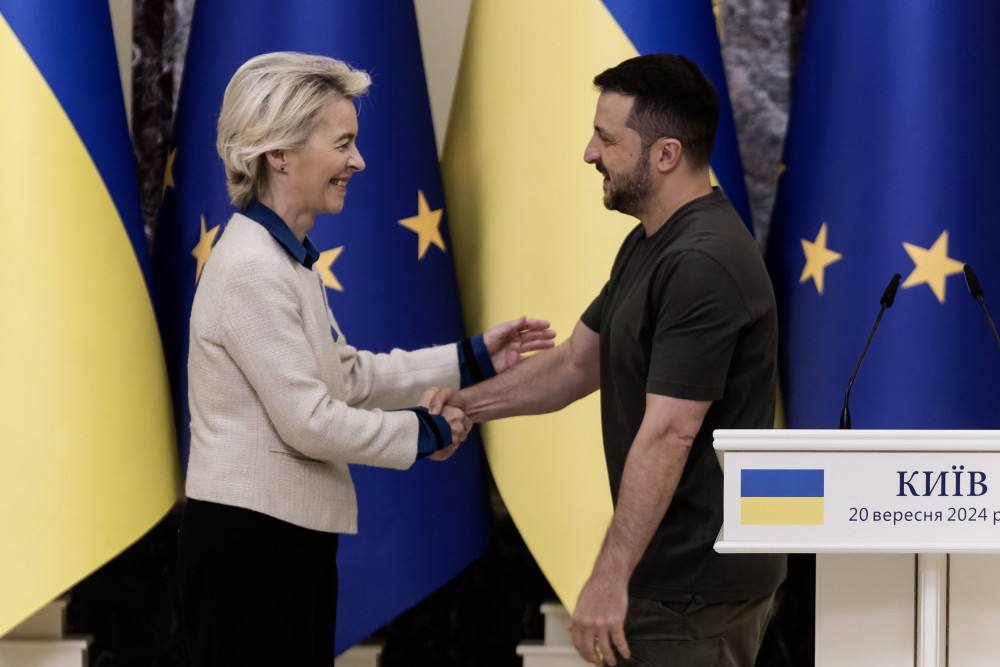Europe on the Ukrainian Front
Von der Leyen in Kyiv: Europe’s Support for Ukraine
Europe on the Ukrainian Front: Following the European Parliament vote, Von der Leyen heads to Kyiv. Zelensky: We want peace, not a frozen conflict. Ursula von der Leyen arrived in Kyiv on the morning of September 20 for her first visit to Ukraine since beginning her second term as President of the European Commission. Von der Leyen met with President Volodymyr Zelensky a day after the European Parliament voted to authorize the use of Western weapons in Russia and prepare for winter, discussing Europe’s support for Ukraine. In fact, about half of Ukraine’s energy infrastructure has been destroyed by Russian bombings, causing rolling blackouts that leave entire regions of the country in darkness for hours.
The President said that all of Latvia, Lithuania, and Estonia have lost power and explained that the heating season will begin in two weeks, and the continuous attacks on Ukraine’s civilian energy infrastructure are certainly aimed at causing maximum damage. He added that Europe will assist Ukraine in its brave efforts to overcome this issue.
The Divisive Resolution
This visit comes a day after the European Parliament, by passing a non-binding resolution, called on member states to allow Ukraine to strike legitimate military targets within Russian territory with their weapons. By doing so, the Strasbourg assembly is urging the 27 members to overcome silence and restrictions and allow Ukraine to fully exercise its right to self-defense.
The resolution was passed with 425 votes in favor, 131 against, and 63 abstentions. The issue of using Western weapons on Russian soil has long been a major topic of debate between supportive governments, convinced that authorizing attacks on Russian soil is the only way to force Moscow to negotiate, and opponents, who are always concerned that such a decision could backfire and lead to an escalation of the conflict.
The approved text also calls for strengthening sanctions against Iran and North Korea for their military support to Moscow and urges the European Union and the international community to establish a legal regime for confiscating frozen Russian assets as part of efforts to compensate for the extensive damages inflicted on Ukraine.
One Million Victims
Meanwhile, the total number of victims has reached one million since the conflict began, sparking much debate on both fronts. This hypothesis is put forward by the Wall Street Journal based on confidential documents and intelligence information, considering that official figures are also kept secret to protect the morale of civilians in Moscow and Kyiv.
According to this American newspaper, determining the exact number of dead and injured in this conflict is difficult because Russia and Ukraine refrain from releasing official estimates and sometimes publish unreliable figures. Leaked Pentagon documents reported by The Economist in July indicate that Russian casualties could be even higher, with the highest estimate being 728,000 soldiers killed, wounded, or captured. Moscow has not announced its own casualty numbers in this war, and according to the latest figures provided in September 2022, 5,937 soldiers had been killed.
In contrast, Ukraine’s confidential estimate from earlier this year shows Kyiv’s losses as 80,000 soldiers killed and 400,000 wounded, writes the Wall Street Journal, noting that President Zelensky had presented a much lower number of military casualties in February without disclosing the number of injured soldiers. These losses, according to the newspaper, highlight the long-term destructive impact on two countries that were already struggling with population decline before the war, primarily due to economic turbulence and social changes.
Waiting for November 5
We are all interested in a peace that is not a frozen conflict, Zelensky said today at a press conference with Von der Leyen in Kyiv. Peace must be reliable. However, at present, there seems to be no truly prominent diplomatic horizon. A prospect that is unlikely to change before November 5, the date of the U.S. presidential elections. Regarding Ukraine, the White House’s support for Kyiv is at risk, partly confirmed by Donald Trump’s lack of response to the debate a few days ago and the peace plan presented by J.D. Vance, the Republican vice-presidential candidate, which largely follows Kremlin demands.
The possible change in the balance of power is one of the reasons for the intensification of field conflicts in recent weeks. Similarly, Kyiv is increasing pressure in an attempt to reach a negotiation from a more advantageous position, which many now consider inevitable.
Following the peace summit in Switzerland, international expectations about a withdrawal plan in Ukraine have increased. Several factors have revived hopes, including the second summit announced by Zelensky, which, at least in the Ukrainian President’s intention, should also include Russia. Moscow, which periodically states it is ready to talk, and Ukrainian public opinion, which according to polls, is more open to negotiation.
However, the hope of achieving a ceasefire is weak, let alone a peace agreement that would be sustainable over time. The first peace summit emphasized Ukraine’s ability to bring together a large number of diplomats and political leaders but did little to advance negotiations. It even highlighted the often ambiguous stance of many Global South countries, like India or Brazil. Zelensky has publicly broadcast the message of peace and diplomacy that Western public opinion needs to hear, but the reality is that neither side is ready to meet the conditions necessary to sit at the negotiating table, ready to make even painful compromises.

